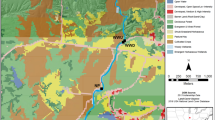Abstract
The important role of bacteria in sediments is reviewed. The problems in estimating bacterial biomass in sediments are highlighted. Recent developments in studying substrate transformations in the laboratory, under conditions simulating the nutrient status occurring in nature, are also discussed.
Access this chapter
Tax calculation will be finalised at checkout
Purchases are for personal use only
Preview
Unable to display preview. Download preview PDF.
Similar content being viewed by others
References
Azam, F. & B. C. Cho, 1987. Bacterial utilization of organic matter in the sea. In M. Fletcher, T. R. G. Gray & J. G. Jones (eds.), Ecology of Microbiol Communities. Soc. for gen. Microbiol. Symp. 41. Camb. Univ. Press, Camb: 261–281.
Balch, W. E., G. E. Fox, L. J. Magrum, C. R. Woese & R. S. Wolfe, 1979. Methanogens: Revaluation of a unique biological group. Microbiol. Rev. 43: 260–296.
Brown, C. M., D. C. Ellwood & J. R. Hunter, 1977. Growth of bacteria at surfaces: influence of nutrient limitation. FEMS Microbiol. Lett. 1: 163–166.
Burns, R. G., 1979. Interaction of microorganisms, their substrates and their products with soil surfaces. In D. C. Ellwood, J. Melling & P. Rutter (eds.), Adhesion of Microorganisms to Surfaces. Soc. for. Gen. Microbiol. Special Publ. No. 2. Acad. Press, London: 109–138.
Chrzanowski, T. H., L. H. Stevenson & B. Kjerfve, 1979. Adenosine 5′ triphosphate flux through the north inlet marsh system. Appl. envir. Microbiol. 37: 841–848.
Costerton, J. W., R. T. Irvin, K-J. Cheng, 1981. The bacterial glycocalyx in nature and disease. Ann. Rev. Microbiol. 35: 299–324.
Ellwood, D. C, J. Melling & P. Rutter (eds.), 1979. Adhesion of Microorganisms to surfaces. Soc. for gen. Microbiol. Spec. Pub. No. 2. Acad. Press, London, 216 pp.
Fletcher, M. & K. C. Marshall, 1982. Are solid surfaces of ecological significance to aquatic bacteria? Adv. microbiol. Ecol. 6: 199–236.
Fry, J. C. & N. C. B. Humphrey, 1978. Techniques for the study of bacteria epiphytic on aquatic macrophytes. In D. W. Lovelock & R. Davies (eds.), Techniques for the Study of Mixed Populations. Soc. appl. Bacteriol. Tech. Series 11. Acad. Press, London: 1–29.
Hamilton, W. A., 1987. Biofilms: Microbial interactions an metabolic activities. In M. Flletcher, T. R. G. Gray & J. G. Jones (eds.), Ecology of Microbial Communities. Soc. for gen. Microbiol. Symp. 41. Camb. Univ. Press, Camb: 361–385.
Jones, J. G., 1982. Activities of aerobic and anaerobic bacteria in lake sediments and their effect on the water column. In Sediment Microbiology. Soc. gen. Microbiol. Special Pub. No. 7 Acad. Press London: 107–145.
Jones, R. D. & R. Y. Morita, 1985. Survival of a marine ammonium oxidiser underenergy-source deprivation. Mar. Ecol. 26: 175–179.
Keith, S. M, R. A. Herbert & C. G. Harfoot, 1982. Isolation of new types of sulphate-reducing bacteria from estuarine and marine sediments using chemostat enrichments. J. appl. Bacteriol. 53: 29–33.
Luscombe, B. M. & T. T. G. Gray, 1971. Effect of varying growth rate on the morphology of Arthrobacter. J. gen. Microbiol. 69: 433–434.
Macfarlane, G. T. & R. A. Herbert, 1985. The use of compound continuous flow diffusion chemostats to study the interaction between nitrifying and nitrate-reducing bacteria. FEMS Microbiol. Ecol. 1: 249–254.
Marshall, K. C, 1976. Interfaces in Microbial Ecology. Harvard Univ. Press, Camb., USA, 156: pp.
Marshall, K. C, R. Stout & R. Mitchell, 1971. Selective sorption of bacteria from sea water. Can. J. Microbiol. 17: 1413–1416.
Moriarty, D. J. W., 1977. Improved method using muramic acid to estimate biomass of bacteria in sediments. Oecologia (Berl.) 26: 317–323.
Morita, R. Y., 1985. Starvation and miniaturisation of heterotrophs, with special emphasis on maintenance of the starved viable state. In M. Fletcher et al. (eds.). Bacteria in their Natural Environments. Soc. for gen. Microbiol. Acad. Press. London: 111–130.
Nishio, T. & I. Koike & A. Hattori, 1982. Estimates of denitrification and nitrification in coastal and estuarine sediments. Appl. envir. Microbiol. 45: 444–450.
Poindexter, J. S., 1987. Bacterial responses to nutrient limitation. In M. Fletcher, T. R. G. Gray & J. G. Jones (eds.), Ecology of Microbial Communities. Soc. for gen. Microbiol. Symp. 4L Camb. Univ. Press, Camb: 283–317.
Tempest, D. W., O. M. Neijssel & W. Zevenboom, 1983. Properties and performance of microorganisms in laboratory culture; their relevance to growth in natural ecosystems. In M. Fletcher & G. Floodgate (eds.), Microbes in their Natural Environments. Soc. for gen. Microbiol. Symp. 34, Camb. Univ. Press, Cambridge, 119–152.
Van den Ende, P., 1973. Predator-prey interactions in continuous culture. Science 181: 562–564.
Veldkamp, H., 1977. Ecological studies with the chemostat. Adv. microbial. Ecol. 1: 59–94.
Wilkinson, T. G. & G. Hamer, 1974. Wall growth in mixed bacterial cultures on methane. Biotech. Bioeng. 16: 251–260.
White, D. C., 1983. Analysis of microorganisms in terms of quantity and activity in natural environments. In J. H. Slater, R. Whittenbury & J. W. T. Wimpenny (eds.) Microbes in their Natural Environments. Soc. gen. Microbiol. Symp. 34, Camb. Univ. Press, Cambridge: 37–66.
Author information
Authors and Affiliations
Editor information
Editors and Affiliations
Rights and permissions
Copyright information
© 1989 Kluwer Academic Publishers
About this paper
Cite this paper
Millis, N.F. (1989). Microorganisms and the aquatic environment. In: Sly, P.G., Hart, B.T. (eds) Sediment/Water Interactions. Developments in Hydrobiology, vol 50. Springer, Dordrecht. https://doi.org/10.1007/978-94-009-2376-8_33
Download citation
DOI: https://doi.org/10.1007/978-94-009-2376-8_33
Publisher Name: Springer, Dordrecht
Print ISBN: 978-94-010-9007-0
Online ISBN: 978-94-009-2376-8
eBook Packages: Springer Book Archive




